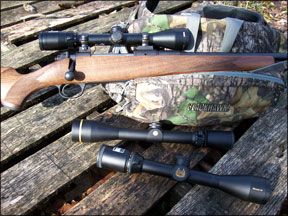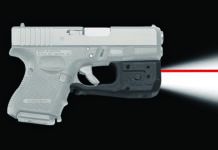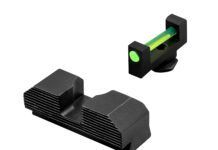Beasts usually like to keep as much woodlot, coulee, or cornfield between us and them as possible, and that may mean shooting our rifle farther than the sighted-in distance. Essentially we use old-fashioned Kentucky elevation and take our best guess at crosshair hold over. Combine a good sense of distance with shooting experience, and you could fill out your tag. If not, you’ll kick up dirt below two sets of hooves, whiz a round high, or, sadly, wound an animal.

Riflescopes with ballistic reticles purportedly take the guesswork out of long-distance shooting by combining a typical crosshair with additional aiming points at set distances. The reticles are calibrated to popular hunting cartridges with muzzle velocities in the range of 2800 to 3000 fps or more. The usual suspects fall into that range—243, 6mm, 25-06, 270, 308, 30-06, 7mm Rem. Mag., 300 Win. Mag., including a slew of others. Since the aiming points are not calibrated to a specific load they, offer general approximations, which means you will need to shoot your rifle to understand how the reticle will work with your specific rifle and cartridge combination. The reticles are chockfull of aiming points and seem cluttered compared to a typical hunting scope, but they are quite easy to master. You may want to make a cheat sheet on an index card or a piece of masking tape and fix it to your stock so you can remember what aiming points are for what distances. Finally, you will still need to know the distance to the target, and some scopes have this covered with built-in range estimators, as you will see.
Our team recently tested three scopes with ballistic reticles: Bushnell’s Elite 3200 with DOA 600 reticle, Leupold’s VX-3 with Boone & Crockett reticle, and Nikon’s Monarch with BDC reticle. We were interested to see if the additional aiming points would be easy to use and hit true to the distance claimed. Since the purpose of these scopes is hunting, a kill zone the size of paper plate, or about 9 inches in diameter, was used to determine whether the aiming points worked. We also looked at light-gathering ability and weather resistance.
To test the scopes, our shooters fixed them to a Kimber model 8400 Classic in 30-06, which is a perfect example of a hunting rifle/caliber combination likely to be found from Montana to Maine. Since the 30-06 is common caliber and is available in a number of bullet styles and weights, we assumed it would fit the scope manufacturers’ criteria as a “popular caliber” as stated in their manuals.
We also wondered if proprietary and not-so-popular calibers that fall into the muzzle velocity range, like those from Weatherby and newer ones like the 30TC, would work with these scopes. Debuting just a few years ago, the 30TC, which is only loaded by Hornady, has less recoil than a 308 or 30-06 yet achieves a higher velocity using the same weight bullet. We tested the 30TC in a Thompson/Center Icon using Hornady 165-grain SST InterLock bullets. We found that what mattered were the velocities and bullet weights. All scopes performed within the calculated range.
Test ammunition consisted of Federal Premium 165-grain Sierra Gameking boattail softpoints and Remington’s Premier Core-Lokt Ultra bonded pointed softpoints in 168 grains. Since the scopes are calibrated to muzzle velocity, we chronographed the factory ammo with a ProChrono chronograph to be sure the Kimber’s 24-inch barrel provided the necessary length for the bullet to pick up speed. After initial sight-in, our test procedure consisted of three-shot groups fired from a bench rest. Starting at 100 yards and progressing to 200 yards, we soon ran out of range, so we fired at 100 yards using the additional aiming points. We used an online ballistic calculator (www.biggameinfo.com) to determine the bullet trajectories. The idea was that the shots should group at a height consistent to the caliber’s trajectory, so the 300-yard aiming point group with the Federal 165-grain bullets should print 4.6 in. high at 100 yards and so on. Light-gathering ability was tested during dusk conditions, and the scopes were frozen for 15 minutes and then placed in warm water for another 15 minutes to test water and fogging resistance.
Shooting took place over numerous sessions at the Fin Fur Feather Club, a members-only facility in Chaplin, Connecticut. Let’s see where the bullets hit the paper.
Bushnell Elite 3200 3-9x40mm DOA 600 Model No. 323940B, $359
Out of the box the Elite 3200 sported lens covers with a bungee cord that was fine for transporting and storage but not suitable for field use. Rainguard is the company’s proprietary coating that helps in light transmission and protects against fogging and condensation. The freezer/warm water test had no effect, with droplets of water wiping off with a lens cloth and leaving no residue. When brought inside from 30F temperatures, the lens fogged, as did the other scopes, but it quickly regained its ability to see faster than the others, we noticed.
The power magnification ring provided a good grip and the right amount of resistance when turning it barehanded or when wearing gloves. The setting was easy to read, with a dot on the tube aligning with the number on the power scale. Windage and elevation caps had rounded edges, giving it a smooth look. Under the caps, the adjustment-scale ring was zeroed by loosening two screws and rotating the ring.
Bushnell calls its ballistic reticle the DOA (Dead On Accurate) 600. It consists of a main duplex-style crosshairs and five additional aiming points. Four additional aiming points combine MOA dots with shorter horizontal crosshairs, and, finally, a short duplex in the 6-o’clock position. Per the manual, the main crosshair was zeroed to 100 yards, thus calibrating the four MOA dot/crosshair combinations to 200, 300, 400, and 500 yards, and the bottom post at 650 yards. To use the additional aiming points, hunters must remember to set the power ring to maximum magnification.
Built into the DOA 600 is a distance estimator called the Rack Bracket System that consists of vertical hash marks on the horizontal crosshairs of the MOA dots. The hash marks are set at 17 in. and 24 in., which are the average width of a mature whitetail’s and mule deer’s ears, respectively. To use this feature, the hunter must find a deer facing or looking directly away from the hunter. Bushnell claims that if the ears fit into the bracket, you have an accurate estimation of range. The Rack Bracket was on the 200, 300, 400, and 500 MOA-dot/crosshair combinations.
Our ammunition was not listed in the manual, but the manual did direct us to a comprehensive list on the Bushnell website. Ammo was listed by cartridge brand and by bullet brands for handloaders.
The Bushnell performed well. Using the 200-yard dot, bullets hit the target dead on. Using the other aiming points, bullets grouped at a height consistent to the bullet’s path for the ranges.
Our Team Said: At first glance the DOA 600 reticle looked like a cross between a wiring schematic and totem pole. Luckily, the manual helped quickly decipher it. Testers liked that they could place the black dots on the target, and that’s where the bullet would hit. The horizontal crosshairs also helped shooters get back on target if they lost the black dot on a dark target. The team liked the range-estimating feature but wondered (with the VX-3 as well) how it would work on game animals of different sizes. It is also wishful thinking that a deer will keep its ears still, but the range estimator was still better than guessing.
Leupold VX-3 3.5-10x40mm Boone & Crockett Big Game No. 66110, $699
The VX-3 sported Leupold’s trademark gold ring on the objective and featured a neoprene jacket that covered the entire scope and was suited for transporting and storage only. The proprietary Argon/Krypton treatment is supposed to nearly eliminate fogging and water proof the scope. It passed the cold/hot test with no issues. Water wiped easily off the lens and no water marks remained. The lens fogged upon entering a heated environment from outside temperatures in the low 30F. A lens cloth quickly took care of it. Proprietary DiamondCoat 2 coating and the Xtended Twilight Lens System evidently provide abrasion resistance and higher light transmission, respectively. The Leupold seemed to have an edge on the others scopes when picking up finer details in dwindling light. The VX-3 had smooth-edged caps giving it a sleek look. Indicator dials are zeroed by rotating a notch in the gold ring to align with zero.
The power ring indicated the magnification power scale as well as estimated range. Numbers facing forward show magnification and numbers facing back specify the range in yards. It took more effort to turn the VX-3’s ring than the Bushnell’s power ring. The high nub on the ring provided the needed leverage.
The Leupold, like the Bushnell, can estimate range by using the reticle’s main duplex. Adjust the power ring while placing the horizontal crosshair on the animal’s back and bottom duplex post to the animal’s brisket then read the number on the power ring to determine approximate distance.
Boone & Crockett (B&C) is the proprietary name for its ballistic reticle. The main crosshair is zeroed to 200 or 300 yards depending on cartridge used. Four additional aiming points include two CPC-style taper crosshairs at 300 and 400 yards, a bar for 450 yards, and the lower duplex post for 500 yards. Per the manual calibers are categorized into one of three groups: A, B or C. Our ammo was not indicated in any of the groupings, but looking at muzzle velocity, caliber, bullet weight and bullet drop at 500 yards we determined our ammo fell into group B. Per the manual, group B calibers specified the main crosshairs be sighted in at 200 yards and to dial in the small triangle on the power ring to use the additional aiming points. Two triangles, a small one for calibers in group B, and a larger one for calibers in group A and C, were easy to distinguish.
At the range the VX-3 performed as promised, with bullets grouping at the correct heights using the aiming points.
Our Team Said: The VX-3 was a great confidence booster. The complexity of the reticle was between the complex Bushnell and the simplistic Nikon. Some thought the 450-yard aiming point should also be a CDC crosshair in lieu of a bar. Just as they became accustomed to the Duplex- and CDC-style crosshairs, the aiming point changed yet again. Consistency would be better. They also felt the list of calibers in the manual was lacking and wanted a more comprehensive list either in print or on the Leupold website. Zeroing the windage/elevation dials was simplest of all scopes. Ultimately, the price nudged the VX-3 slightly behind the Elite 3200.
Nikon Monarch 2.5-10x42mm BDC (Bullet Drop Compensation) Reticle No. BRA12802, $624
The Nikon Monarch was supplied with installed weather-proof lens covers that silently flipped open. A lens cleaning cloth and an anti-fog cloth were included, too. The freezer-to-sink test showed no affect with water wiping cleanly off the lens and no smudges. When we brought the Monarch inside from the cold, the lens fogged and needed to be wiped with a cloth. It took slightly longer for the Monarch to clear than the others, but not that much longer. Nikon’s Ultra ClearCoat Optical System claims to provide bright, sharp images. It did suck up dwindling sunlight and provided very good depth and contrast in shadows. The 42mm objective did not seem to provide an edge over the two 40mms.
The turret caps were large and squared off, giving it a target or tactical scope look. Zeroing the indicator dials on the turrets consisted of unscrewing the set screw with a screw driver or coin, rotating the dial to zero, and snugging up the screw. The power ring on the Monarch took as much effort to turn effort as the VX-3’s. A line in the eyepiece, not the tube body like the others, indicated the power scale, making it easier to read, especially in a shooting position.
The BDC (Bullet Drop Compensation) reticle dispensed with a caliber chart. Nikon is transparent in its manual, stating the reticle was built “…to offer ‘generic’ hold-over points that will accommodate most centerfire rifle cartridges….” If your ammo has a muzzle velocity of 2800 fps, sight in at 100 yards. For calibers with muzzle velocities of 3000 fps or higher, sight in at 200 yards. With our ammo, we sighted in for 100 yards and that gave us four additional aiming points—200, 300, 400 and 500 yards—consisting of open circles along the vertical main crosshair. Shooters must turn the power ring on maximum magnification to use the aiming points. At the range the open circles were the easiest to use and did not cover up the target. All rounds hit within calculated range.
Our Team Said: Nikon got it right with the flip-open lens caps. Plus, the cleaning cloths were a nice, if not practical, touch. They also liked the single screw windage/elevation zero. All testers thought the BDC reticle was super simple to use and especially liked the fact that the circles did not block out the target. Users felt they could get on target faster. Our testers wanted a distance estimator, however, which pushed the Nikon just behind the Bushnell.


















